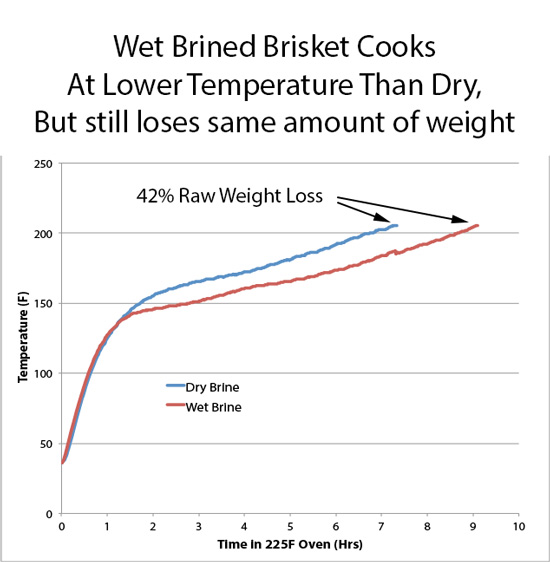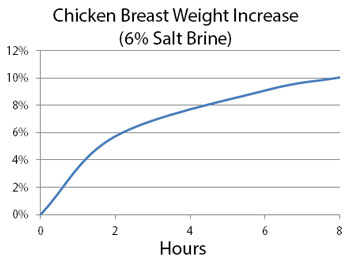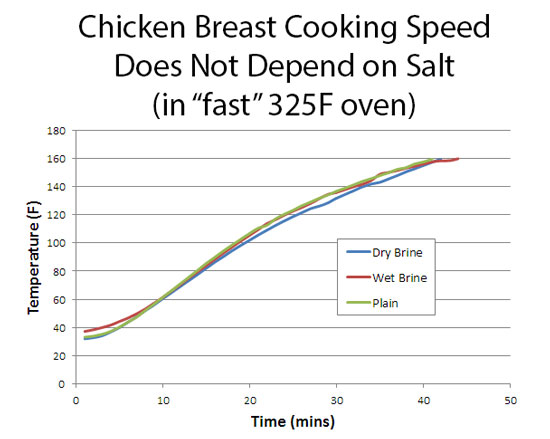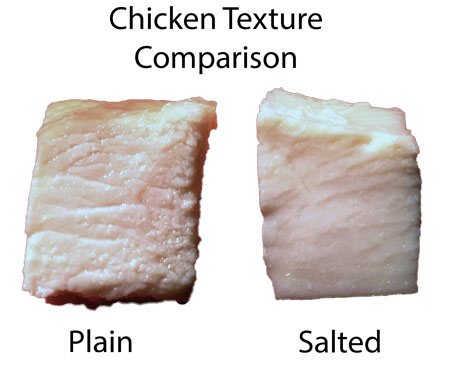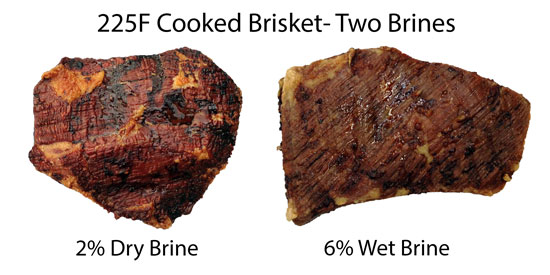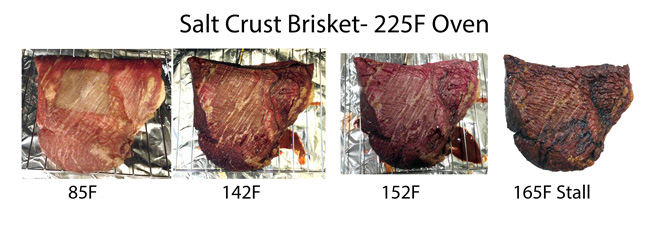| g e n u i n e i d e a s | ||||||
 |
 |
 |
 |
 |
 |
 |
| home | art and science |
writings | biography | food | inventions | search |
| salt of the earth | ||||||||||||
|
Dec 2013 The origin of salt brining is lost in the mists of history. Did a lone shepherd, walking the beaches of the Congo, stumble upon an antelope carcass drenched in salt water, remarkably free of decay, and astonishingly tasty when cooked? Or did a nomadic tribe discover a camel laying on the Kalahari salt flats, its flesh embedded in the dry salt bed, surprisingly red and nourishing? We will probably never know the truth, so must leave this fanciful past for the rigors of the modern kitchen. People continue to brine food today- more for flavor and to retain moisture than to prevent rot- and still must choose between wet and dry brining. Which is best? In dry-brining, salt is rubbed onto the food's surface and left to diffuse inward over time. As we've demonstrated, it takes salt a few minutes to season shrimp, a few hours to fully penetrate a chicken breast, and a few days to arrive at the center of a thick beef brisket. To avoid over-salting food for preservation (and then having to soak out the excess salt for consumption, a step no longer necessary now that bacterial growth is constrained by modern refrigeration), around a half percent of salt by weight is ideal. Great flavor, and very effective at trapping moisture during cooking. With dry-brining, you cannot over-salt if you follow these dosing rules. Whatever quantity of salt is rubbed on the meat ends up inside. Unfortunately, you might not fully cover the meat's surface, inadvertently leaving a few sections unsalted and unprotected. So instead of dry-brining, why not wet-brine in a liquid salt solution which can enter every nook and cranny, and contribute a bit of moisture in the process?
And it does add moisture. Here, we soaked a beef brisket in a 6% salt brine- as you can see, over four days it absorbed around 9% in water weight. Perhaps that extra moisture will help this dry cut stay tender after a few hours baking in the smoker? But how much salt did it absorb? While it is possible to measure the salt concentration of the brine with a fish tank hydrometer or refractometer, and calculate how much has entered the meat and left the brine, most people simply use experience and time as a surrogate for salt concentration. It turns out a few days in a wet 6% brine ends up with the ideal 0.5% salt concentration inside the brisket0. An hour or so works for a thin chicken breast or wings. So does wet vs dry brining make a difference? Here we dry-brined a brisket with a 1% salt rub for two days (higher salt levels than normal to accentuate any differences). Versus the wet-brined brisket shown above, in a 6% salt solution for over 4 days. Both briskets were placed in the oven and cooked at 225F until they reached 203F1. As you can see in this chart, for over six hours the wet brined brisket remained cooler than the dry brined- evaporation makes all the difference:
But interestingly, when cooking low and slow, all the extra moisture absorbed by the meat evaporated by the time it hit 203F. Remarkably, BOTH briskets weighed the same when removed from the oven, even though the wet brined brisket started out 10% heavier. And, in a blind taste test, both were equally tender and moist. We then repeated the experiment, this time with a chicken breast. Chicken cooks fast and hot, so perhaps the added moisture from wet brining will make a difference. And indeed it does. Here we dry rubbed a half pound chicken breast at the 1.5% salt level (too high for eating, but large enough to detect a difference in cooking). Versus a 6% wet-brined breast, which also created a 1.5% salt level inside the meat due to the 8 hour immersion. Once again, the brined meat absorbed around 10% in water weight:
The meat was then cooked in a 325F oven, along side an unbrined control. Unlike the low and slow brisket case, all three breasts cooked at the same rate. In a hot oven, evaporative cooling cannot keep up with the influx of heat. The moisture simply doesn't have time to ooze out, either. One reason why fast grilling keeps food moist (though at these temperatures, a few minutes too long on the grill can tip a meal from juicy to jerky).
All three breasts were removed from the oven when they hit 160F. Now, the weight loss difference was clearer:
As a percentage of the original raw weight, the wet-brined breast lost half as much weight as the untreated meat! In other words, some of the absorbed water remained in the meat. It was slightly juicier, too. But not by much compared to the dry-brine. More evident was the critical role of salt. Salt ions act like electrostatic glue, preventing moisture from easily leaving the meat. This effect is dramatic- compare the appearance of all three breasts cooked in this experiment:
The plain breast was shriveled and less tender compared to either brined breast. Nothing you would really want to serve to your guests2. So is this the complete story? Always brine, but wet brine if you cook food quickly, and use either method for low and slow? Ah, if the world were only this simple. Salt has a secondary effect on meat proteins. At high concentration levels, salt actually causes meat proteins to break apart. The dangling protein ends are free to bond with other dangling ends and water, creating a meat gel or polymer. For example, in ground beef, over-salting turns a tender meatball into a hockey puck. This texture difference extends to the interior of the three chicken breasts above, where the muscle structure in both brined samples has been rearranged by the salt, and re-bonded into a more homogeneous mass:
At what level does meat become plasticized? Around 1.5% to 2%. Which is way too salty to eat. Fortunately our intended target salt level is only 0.5%, which adds flavor while holding onto moisture. But with either method it will exceed 2% on the surface. The dry-brined surface is at 100% salt levels under each salt crystal, and the wet-brined is at 6% everywhere. Fortunately, very little of this salt can force its way into the bulk of the meat very quickly, which is why the cooked levels remain low, even though the starting levels are high. Does this high surface level affect other important food characteristics, such as the bark? Absolutely yes. In the wet vs dry brine brisket experiment above, the wet-brined brisket exuded so much moisture during cooking, the surface never fully browned (cooked in a humid oven without smoke, to make the difference visible). This excess moisture prevents a crisp bark from forming until the very end, when the absorbed water has evaporated. The dry-brined surface is harder and mahogany colored- the wet brined was gray until the very last hour.
But dry brining has its own peculiar effects. Here, we dry brined a brisket by covering a square section with a crust of kosher salt. As long as you wash the salt off after 90 minutes, the total amount of absorbed salt still averages under 0.5%, so this is a fast and viable brining method. But the crust of salt does attack the meat. This photo sequence illustrates how the brisket under the salt turns deep red, just as if the meat were being fully corned:
When cooked in an oven, the salted area browns almost immediately due to the large number of broken protein bonds that easily participates in the Maillard reaction. A remnant of the square salted area (rotated as the collagen shrinks and the meat swells) is still visible into the stall:
We repeated this salt crust experiment in an electric smoker, which produces a lot of smoke but the wrong mix of chemicals to generate a smoke ring. Note the smoke penetration in the salted area is reduced- the polymerized surface was dry and not welcoming to smoke deposition. Spraying or mopping can delay bark formation and help smoke adhere, but a highly salted surface will lack smoke flavor on its own.
What to do? I like the precision, control and lack of mess with dry brining. So I adopt a technique recommended by many barbecuing professionals- in your dry rub, use coarse salt and herbs. This limits the high salt concentration areas to isolated islands, so the surface can still "breath" between the polymerized dots. Especially if you don't tightly wrap your meat over night, but loosely cover on a rack. A compromise, but salt still diffuses inward beneath the islands and flavors the bulk of the meat over time. And the surface will absorb smoke from between the islands. So when brining:
|
||||||||||||
|
--------------------------------------------------------------------------------------------------------
0 If the meat absorbs 9% of its weight in salt water, and that water contains 6% salt, all things being equal the meat contains 9% *6% =0.54% salt by weight. However, salt does not diffuse at the same rate as water through cells walls, but does pass through cracks and capillaries. So the salt level is a bit lower than this calculation indicates beef, and usually higher in seafood and poultry. We measured the actual levels using chemical analysis. 1 203F is a typical stopping point when smoking brisket. But it is only a guide. Actually, the stopping point is determined by when the brisket is done, e.g. the collagen fully converted to silky gelatin and the fat translucent. In a very humid smoker, this point might be reached after 13 hours when the internal temperature reaches 198F. Or it might take 9 hours in hotter smoker where you wrapped in foil when the internal temp hit 150F, and then rested in a faux cambro after it reached 195F. Time, temperature and humidity all interact synergistically- for all these reasons, a recipe that works for one cook will fail in a different smoker for a different cook. Temperature is not a universal stop sign... 2 Well, maybe. The unsalted breast was a bit more fibrous, but no more so than a steak. It did, however, taste more "chickeny". The salted breasts are tender, and if you plan on slicing the meat for a fajita, or soaking in bbq sauce, or waiting a day before eating, a brined breast is the way to go. But immediately sliced on a salad, the flavor is too bland for my taste. 3 Injecting brine is a faster version of wet-brining, and offers similar results in a shorter time. Injection can make sense in competition cooking where time is a factor, but I prefer dry brining at home. Still, if you inject a concentrated salt solution (only enough to average out to a 0.5% salt level), but not salt the surface, you may achieve the best of all worlds. On my list of future experiments. Let me know if you already use this method. |
||||||||||||
 Contact Greg Blonder by email here - Modified Genuine Ideas, LLC. |
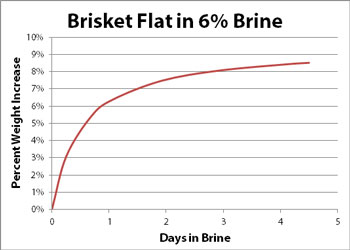 In wet-brining, food is typically immersed in a salt/water solution of around
In wet-brining, food is typically immersed in a salt/water solution of around 